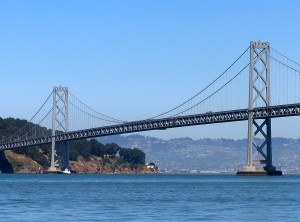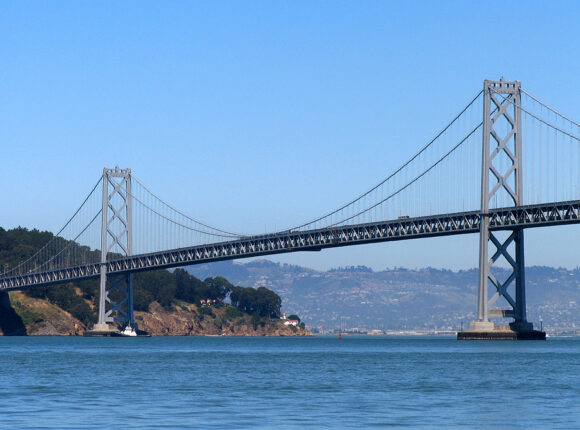A California Senate report released Wednesday on the construction of the new eastern span of the San Francisco-Oakland Bay Bridge raises questions about the quality of workmanship used to build the $6.3 billion span.
The report by the state Senate’s Transportation and Housing Committee contains testimony from engineers that question the durability of welds on bridge pieces produced in China and the integrity of large bolts used to hold earthquake-safety equipment in place.
 Still, both engineers say that despite the defects, they don’t believe the bridge to be unsafe, but that parts of it will need expensive retrofitting sooner than they should.
Still, both engineers say that despite the defects, they don’t believe the bridge to be unsafe, but that parts of it will need expensive retrofitting sooner than they should.
The report’s investigators found that California Department of Transportation managers dismissed concerns from quality-assurance experts that the Chinese firm Shanghai Zhenhua Heavy Industry Co. Ltd, or ZPMC, hired to do key bridge welds, lacked the experience to meet standards.
James Merrill, an engineer who oversaw weld inspections in China, told investigators that his staff found hundreds of weld cracks. He told Caltrans officials they were taking a “great risk” in allowing ZPMC to do the work, according to the report.
At the time, the contract with ZPMC called for no cracks at all, so Merrill’s firm MacTec Engineering rejected the pieces, leading to severe delays.
Merrill said Caltrans was concerned about the delays, and that he was told he was being “too rigorous” in his inspections.
Caltrans failed to renew MacTec’s contract after the disagreement over ZPMC’s work and hired another firm, Alta Vista Solutions, that turned out not to be qualified for the job, according to the report.
Bridge spokesman Andrew Gordon said officials would address the report’s findings at a meeting on Friday before the committee.
The report also found that Caltrans forced another of its supervising bridge engineers off the job after supervising work on the welds being conducted in China.
“The Chinese were not catching stuff,” former Caltrans bridge engineer Douglas Coe, a 25-year department veteran, told the report’s authors. “Why are we finding all these cracks?”
Coe said he felt pressure from bridge managers Tony Anziano and Peter Siegenthaler not to stop work, and that eventually he argued that Caltrans should change the language in the contract – which permitted no cracks in the welds – if managers were going to order them through.
Caltrans eventually changed that language.
“This is the first time in my career the engineering wasn’t allowed to be done right,” Coe told investigators. “I’m mad as hell that the Department (Caltrans) put me in a position to have to say this. … But if that bridge starts to crack in five years it’s all going come out.”
Caltrans’ Anziano and Siegenthaler told the investigators that the weld cracks in question were repairable and have been mostly fixed. They maintain that the bridge is safe.
“No one was discouraged in reporting quality assurance,” Anziano said in the report.
The report also faulted Caltrans with allowing a number of giant steel bolts to be installed despite a lack of quality-assurance testing.
Instead of rejecting the bolts, Caltrans managers “resolved the situation by changing the specifications on the bolt fabrication contract and then accepted them ‘as is,’ ” the report found.
Dozens of the bolts ended up snapping after being tightened in March, leading to a $25 million repair job.
MacTec’s Merrill told investigators that he suggested the bolts undergo more testing.
“I got told we weren’t doing any testing and to stop mentioning it,” Merrill told the panel’s investigators. “I was basically told to stop bringing it up. That was the end of that.”
Caltrans has disputed that it dismissed quality-assurance concerns to get the bolts installed on time.
Was this article valuable?
Here are more articles you may enjoy.


 Cyber Breach Affected 750,000 Canadian Investors, Regulator Says
Cyber Breach Affected 750,000 Canadian Investors, Regulator Says  Tesla, EEOC Plan Talks to Settle Factory Racism Suit
Tesla, EEOC Plan Talks to Settle Factory Racism Suit  First Brands Judge Approves Examiner to Probe Fraud Allegations
First Brands Judge Approves Examiner to Probe Fraud Allegations  Billionaire NFL Owner Suing Over Billboards Near His SoFi Stadium
Billionaire NFL Owner Suing Over Billboards Near His SoFi Stadium 